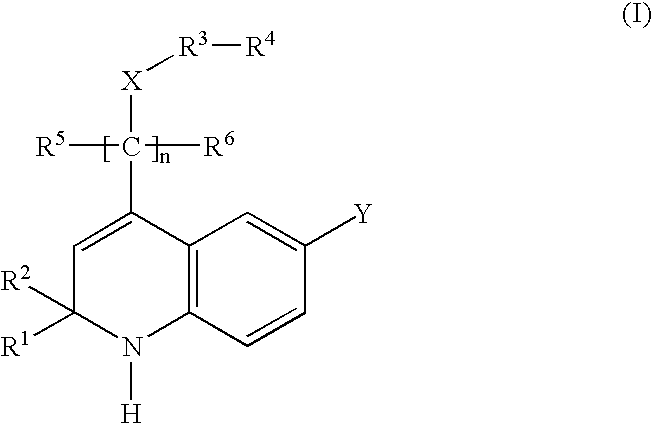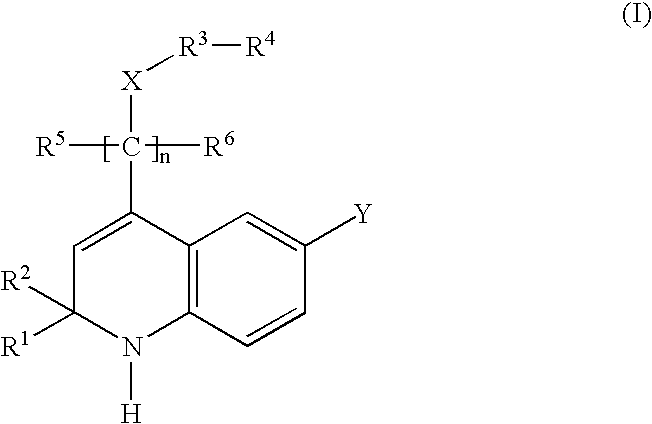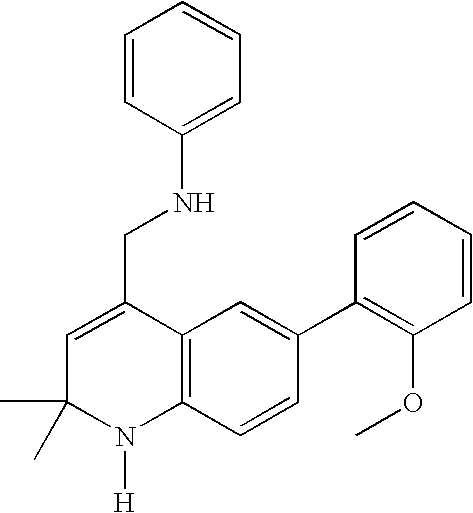Glucocorticoid mimetics, methods of making them, pharmaceutical compositions, and uses thereof
a technology of glucocorticoid mimetics and ligands, applied in the field of glucocorticoid mimetics or ligands, can solve the problems of increased transcription rate, severe and life-threatening, and number of adverse side effects
- Summary
- Abstract
- Description
- Claims
- Application Information
AI Technical Summary
Benefits of technology
Problems solved by technology
Method used
Image
Examples
experimental examples
Example 1
Synthesis of [6-(2-methoxyphenyl)-2,2-dimethyl-1,2-dihydroquinolin-4-ylmethyl]phenylamine
A mixture of 20.8 g of 4-bromonitrobenzene and 17.2 g of 2-methoxyphenyl boronic acid in 340 mL of ethylene glycol dimethyl ether and 170 mL of 2 M sodium carbonate solution was purged with argon gas and then 3.6 g of Pd(PPh3)2Cl2 was added under argon atmosphere. The reaction mixture was heated in a sealed flask at 120° C. overnight. The reaction mixture was cooled down to room temperature. The mixture was filtered through diatomaceous earth and the filtrate was diluted with water and the product was extracted three times with EtOAc. The organic layers were combined, dried over magnesium sulfate (MgSO4), and the solvent was evaporated in vacuo. The residue was purified by flash chromatography to yield 17.1 g of 2-methoxy-4′-nitrobiphenyl as a solid.
A mixture of 52.4 g of 2-methoxy-4′-nitrobiphenyl and 76 g of ammonium formate in 640 mL of methanol was treated with 6.4 g of 10% Pd / C at ...
example 2
Synthesis of 4-Allylsulfanylmethyl-6-(2,6-dimethoxyphenyl)-2,2-dimethyl-1,2-dihydroquinoline
5 g of 4-bromonitrobenzene, 6.2 g of 2,6-dimethoxyphenyl boronic acid, 2 mL of a 2 M sodium bicarbonate solution, and 800 mg of bistriphenylphosphinyl palladium (II) chloride were reacted as described in the first step of Example 1 to afford 4.5 g of the biphenyl intermediate.
Following the procedure described in Example 1, 4 g of the above biphenyl, 6 g of ammonium formate, and 2 g of Pd / C gave 3.6 g of the corresponding aniline, which was reacted with 1.3 g of iodine and 13 g of magnesium sulfate in acetone to produce 1.6 g of the desired dihydroquinoline. The above dihydroquinoline (1.3 g) reacted with 823 mg of NBS to provide the 4-bromomethyl derivative. Reaction with 0.4 mL of allyl mercaptan afforded 720 mg of the title compound.
The following compounds were prepared beginning with the appropriate aryl boronic acid using procedures analogous to those described in Example 2.
4-Allylsulfany...
example 3
Synthesis of N-[6-(2-methoxyphenyl)-2,2-dimethyl-1,2-dihydroquinolin-4-ylmethyl]benzamide
To a round bottom flask equipped with a stir bar was added 4-bromomethyl-6-(2-methoxyphenyl)-2,2-dimethyl-1,2-dihydroquinoline (see Example 1) (0.36 mmol), DMF (3.6 mL), and NaN3 (0.54 mmol, 1.5 equiv). The reaction was stirred 48 hours under argon, then diluted with EtOAc and water, separated, and the aqueous phase was extracted with EtOAc. The combined organics were washed with water. The water was back-extracted with EtOAc and the combined organics were washed with brine and concentrated in vacuo. The residue was diluted with hexanes and a minimal amount of EtOAc and applied to a silica gel column. Flash chromatography, eluting with 0-30% EtOAc / hexanes provided 181 mg of 4-azidomethyl-6-(2-methoxyphenyl)-2,2-dimethyl-1,2-dihydroquinoline as a brown oil.
A round bottom flask equipped with a stir bar was charged with 4-azidomethyl-6-(2-methoxyphenyl)-2,2-dimethyl-1,2-dihydroquinoline (0.565 mmol...
PUM
| Property | Measurement | Unit |
|---|---|---|
| Mass | aaaaa | aaaaa |
| Mass | aaaaa | aaaaa |
| Mass | aaaaa | aaaaa |
Abstract
Description
Claims
Application Information
 Login to View More
Login to View More - R&D
- Intellectual Property
- Life Sciences
- Materials
- Tech Scout
- Unparalleled Data Quality
- Higher Quality Content
- 60% Fewer Hallucinations
Browse by: Latest US Patents, China's latest patents, Technical Efficacy Thesaurus, Application Domain, Technology Topic, Popular Technical Reports.
© 2025 PatSnap. All rights reserved.Legal|Privacy policy|Modern Slavery Act Transparency Statement|Sitemap|About US| Contact US: help@patsnap.com



